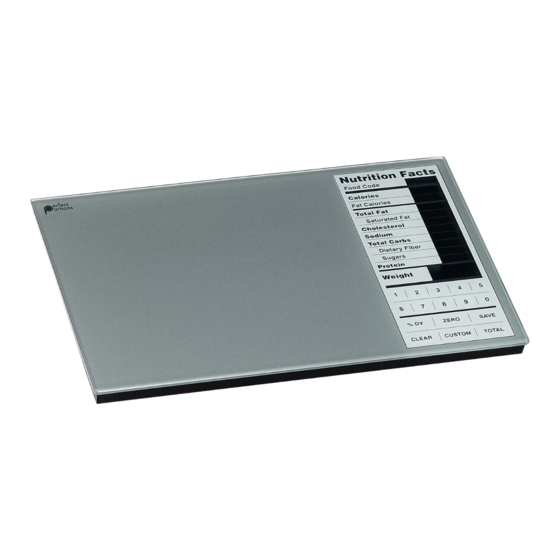
Table of Contents
Advertisement
Advertisement
Table of Contents

Summary of Contents for Perfect Portions NUTRITION SCALE
- Page 1 NUTRITION SCALE, INSTRUCTION MANUAL...
-
Page 2: Table Of Contents
TABLE OF CONTENTS BA SI C I N ST R U CT IO N S & T I P S 2 I NT R O D UC T I O N 3 G E TT I N G T O K N OW Y O U R S C A LE 4 SCA L E F U N C T I ON S TURN I NG SCA L E O N/O F F 6 WEI GH I NG I TEMS 6... -
Page 3: Ba Si C I N St R U Ct Io N S & T I P S
BASIC INSTRUCTIONS 1. Place the scale on a clean, level surface. Press the ON/OFF key on the right side of the scale; the four digit food code will be blinking. 2. To use a plate or other container to weigh food, put empty plate and/or container on scale. -
Page 4: Introduction
INTRODUCTION Welcome to your new Perfect Portions Scale—a state- of-the-art Nutrition Scale that weighs your food and si- multaneously calculates the amount of 10 key nutritional elements: - Calories - Calories from Fat - Carbohydrates (in grams) - Protein (in grams) -
Page 5: Getting To Know Your Scale
This mode is useful for tasks such as displaying cumulated nutritional information over the course of a day. THE DISPLAY – the Perfect Portions scale displays the 10 different nutritional values and the weight in grams or pounds and ounces. The food code number for the food being weighed also appears in the display window. - Page 6 GETTING TO KNOW YOUR SCALE THE CONTROLS – includes 18 keys which allow you to select functions, enter numbers (such as those repre- senting food codes), and toggle (switch back and forth) between certain functions. Each function will be ex- plained in detail in the following list.
-
Page 7: Scale Functions
SCALE FUNCTIONS TURNING THE SCALE ON AND OFF – Place the scale on a clean, level surface. Push the ON/OFF button located on the right side of the scale to turn the scale on. Push it again to turn it off. If you don’t make an entry for several minutes, the scale turns itself off automatically WEIGHING ITEMS - When a food is placed on the... -
Page 8: En T Eri N G F O Od Co Des
SCALE FUNCTIONS ENTERING FOOD CODES – The food code is en- tered to tell the scale what is being weighed. Each food has been assigned a code number from 0001 to 1999. Find the food you want to weigh in the Food Code Booklet, arranged by category. -
Page 9: Co M Put I Ng A Me Al
SCALE FUNCTIONS COMPUTING A MEAL – When you have learned how to compute totals, you can use the ZERO function to compute the nutrient value for several food items from a cooked meal by adding them to a plate. Make sure that the total has been cleared before you begin. -
Page 10: En T Eri N G C Ustom F Ood Codes
SCALE FUNCTIONS ENTERING CUSTOM FOOD CODES CONT– When in NORMAL operating mode, press and hold the CUSTOM key until the scale beeps twice. This indi- cates that the scale is now in the PROGRAM mode. The display will be blank except for a “U” and blinking “00”... -
Page 11: C A R I N G F O R Y O U R S C A L
CARING FOR YOUR SCALE CLEANING – Your scale is not waterproof. Never im- merse the scale in water or place it in a dishwasher. To clean the scale platform, use a soft, slightly damp cloth or sponge. For stains or other residue, use a mild dishwashing soap. -
Page 12: Use O F D Ata 1
USE OF DATA The scale contains data derived directly from a U.S. Department of Agriculture Data Base. While the scale is very sensitive and highly accurate, the nutritional content of foods can be variable. The data given is presumed to be accurate for the sample the Govern- ment tested, but there can be significant variability in samples of the same types of food. - Page 13 GLOSSARY NUTRITIONAL TERMS – Your body depends on the food you eat to provide nutrients. Nutrients are chemi- cal substances found in foods that are essential for life processes like breathing, thinking, and digestion. The nutrients found in food are vitamins, minerals, wa- ter, fat, protein, and carbohydrates.
- Page 14 GLOSSARY Fat – Fats occur naturally in foods and play an impor- tant role in nutrition. Fats, oils and some foods like nuts (e.g., peanuts, walnuts, and almonds) are a con- centrated source of energy for the body. Fats store energy in the blood.
-
Page 15: G L O Ss Ary 1
GLOSSARY Protein – Contains complex chains of amino acids necessary for conducting a variety of body functions, such as building tissues, making important body chemicals (e.g., enzymes and hormones and main- taining growth and repair processes). While many plant-based foods, including beans, peas, vegetables, nuts and seeds contain some protein these foods do not contain all the essential amino acids.

Need help?
Do you have a question about the NUTRITION SCALE and is the answer not in the manual?
Questions and answers